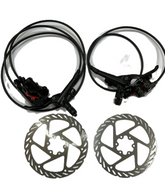Filter
22 results
15
- 10
- 15
- 20
- 25
- 30
- 50
Featured
- Featured
- Best selling
- Alphabetically, A-Z
- Alphabetically, Z-A
- Price, low to high
- Price, high to low
- Date, old to new
- Date, new to old
Sort
Sort by:
- Featured
- Best selling
- Alphabetically, A-Z
- Alphabetically, Z-A
- Price, low to high
- Price, high to low
- Date, old to new
- Date, new to old
-
Discover the power of hydraulic disc brakes, a key component in modern bicycle disc brakes systems. A hydraulic disc brake for cycle uses mineral oil or DOT fluid inside sealed hoses to transfer force smoothly from the brake lever to the caliper. When you...
- Rs. 2,399.00
- Rs. 2,399.00
- Unit price
- / per
-
Upgrade your bike's braking with new disc brake rotors which are ideal for heavy duty use. Enjoy improved responsiveness and control for all riding conditions.Regular replacement of worn out disc rotor prevents dangerous situations, offering better performance and safety. Specifications: Item : Disc Rotor...
- Rs. 389.00
- Rs. 389.00
- Unit price
- / per
-
Upgrade your ride with the JAK7 Mechanical Disc Brake, designed for high performance on MTB and hybrid cycles. This reliable bicycle brake machine offers strong stopping power and smooth control, making it ideal for daily rides and off-road adventures. Brand: JAKQuantity: 1 Machine (Caliper)...
- Rs. 950.00
- Rs. 950.00
- Unit price
- / per
-
The Disc Machine is the perfect solution for cyclists who want to maintain, upgrade, or repair their bicycle disc brakes. Built for precision, this tool ensures your disc brake for cycle delivers top performance in every ride. Whether you are replacing worn bicycle disc...
- Rs. 350.00
- Rs. 350.00
- Unit price
- / per
-
High-Performance Bicycle Disc Brake Rotors – Enhanced Safety & Control Upgrade your bike’s braking with our bicycle disc brakes designed for heavy-duty use. Perfect for both casual riders and serious cyclists, these rotors deliver improved responsiveness and consistent stopping power across all riding conditions....
- Rs. 550.00
Rs. 799.00- Rs. 550.00
- Unit price
- / per
-
Upgrade your ride with the high-quality Trioblade disc brake set, designed for reliable performance and safety. This package includes 2 durable disc calipers and 2 precision-engineered 160 mm disc rotors, delivering consistent stopping power in all conditions. Perfect for enhancing your bike’s braking system,...
- Rs. 799.00
- Rs. 799.00
- Unit price
- / per
-
With Trioblade Disc Machine, Upgrade your bike's braking with new disc brake rotors which are ideal for heavy duty use. Enjoy improved responsiveness and control for all riding conditions.Regular replacement of worn out disc rotor prevents dangerous situations, offering better performance and safety. Specifications:...
- Rs. 1,000.00
Rs. 1,500.00- Rs. 1,000.00
- Unit price
- / per
-
Upgrade your bicycle’s stopping power with the BRAKE SET – V BRAKE 26 CITY, designed for smooth, reliable performance in all urban riding conditions. While it’s an excellent alternative to bicycle disc brakes, this set offers consistent braking force and low-maintenance operation for daily...
- Rs. 300.00
- Rs. 300.00
- Unit price
- / per
-
Upgrade your ride with the DISC MACHINE, designed for powerful and consistent braking performance. Engineered for durability and precision, this rotor is perfect for riders seeking enhanced control in all conditions. Whether you’re commuting, touring, or off-roading, it delivers reliable stopping power for your braking...
- Rs. 349.00
Rs. 599.00- Rs. 349.00
- Unit price
- / per
-
Enhance your stopping power with this Brake Lever, built for reliability, comfort, and smooth performance. Designed to work seamlessly with bicycle disc brakes, disc brake for cycle systems, and V BRAKES, this lever provides precise control for safe and confident riding. Crafted from high-quality...
- Rs. 200.00
- Rs. 200.00
- Unit price
- / per
-
Upgrade your braking performance with this Brake Cable for Disc Brake, designed for precision, durability, and smooth operation. Whether you need a bike brake wire, bicycle brake wire, or cycle brake wire, this premium cable ensures reliable stopping power for all riding conditions. Crafted...
- Rs. 100.00
- Rs. 100.00
- Unit price
- / per
-
Buzzer Disc Machine – High-Performance Disc Brake System for Bicycles Upgrade your bike’s stopping power with the Buzzer Disc Machine, a premium rotor designed for bicycle disc brakes. Perfect for heavy-duty use, it delivers improved responsiveness, control, and safety across all riding conditions. Crafted...
- Rs. 585.00
Rs. 850.00- Rs. 585.00
- Unit price
- / per
-
JAK Disc Machine – High-Performance Disc Brake System for Bicycles Upgrade your bike’s stopping power with the JAK Disc Machine, a premium rotor designed for bicycle disc brakes. Perfect for heavy-duty use, it delivers improved responsiveness, control, and safety across all riding conditions. Crafted from...
- Rs. 959.00
Rs. 1,500.00- Rs. 959.00
- Unit price
- / per
-
TEKTRO MD-M280 Mechanical Disc Brakes – Reliable Performance for Every Ride Experience smooth, consistent, and dependable stopping power with Tektro Mechanical Disc Brakes. Designed for riders who demand durability and performance, this set features a high-quality two-piece aluminium and steel caliper body, paired with...
- Rs. 1,850.00
Rs. 2,500.00- Rs. 1,850.00
- Unit price
- / per
-
Tektro MD-M280 Mechanical Disc Brakes – Reliable Performance for All Riders Upgrade your bicycle disc brakes with the high-performing Tektro MD-M280 Mechanical Disc Brake system, designed for smooth, consistent, and dependable stopping power in all riding conditions. Featuring a durable two-piece aluminium/steel caliper body...
- Rs. 1,850.00
- Rs. 1,850.00
- Unit price
- / per


















